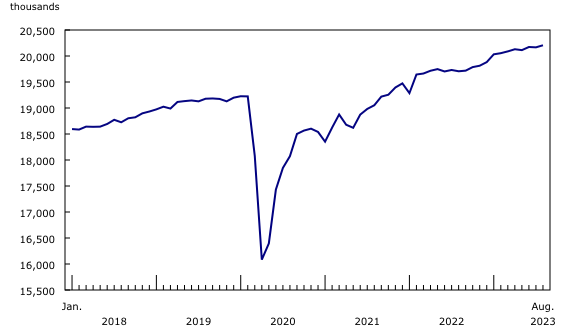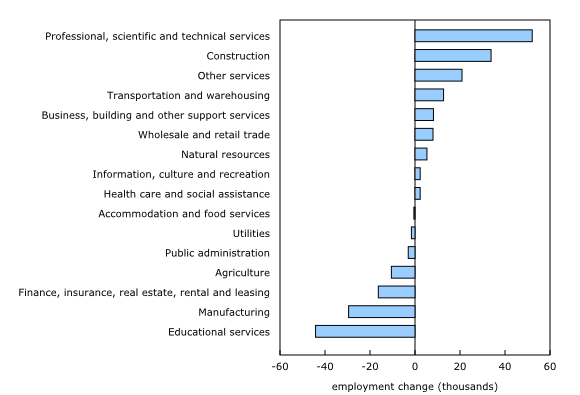Labour Force Survey, August 2023
Released: 2023-09-08
Highlights
Employment rose by 40,000 (+0.2%) in August. This increase in employment was outpaced by population growth (+103,000; +0.3%) and the employment rate—the proportion of the population aged 15 and older who are employed—fell 0.1 percentage points to 61.9%.
The unemployment rate was unchanged at 5.5%, following three consecutive monthly increases in May, June and July.
Employment increased among core-aged men (+33,000; +0.5%) and women (+21,000; +0.3%) aged 25 to 54 years, while employment declined among women aged 55 and older (-27,000; -1.3%). Employment for female youth increased (+32,000; +2.4%), while it declined among male youth (-29,000; -2.1%).
Employment increased in professional, scientific and technical services (+52,000; +2.8%) and construction (+34,000; +2.2%) and declined in educational services (-44,000; -2.9%) and manufacturing (-30,000; -1.6%). Employment changes in the other industries were smaller.
Employment rose in Alberta (+18,000; +0.7%), British Columbia (+12,000; +0.4%), and Prince Edward Island (+1,800; +2.0%) in August, while it declined in Nova Scotia (-3,600; -0.7%).
The number of self-employed workers rose by 50,000 (+1.9%) in August, the first notable increase in nine months. There was little change in the number of employees in the private sector or in the public sector.
On a year-over-year basis, average hourly wages rose 4.9% (+$1.56 to $33.47) in August, following an increase of 5.0% in July.
Total hours worked were up by 0.5% in August and by 2.6% on a year-over-year basis.
Among those who were unemployed in July, 57.8% remained unemployed in August—a greater proportion than 12 months earlier (53.4%) (three-month moving averages, not seasonally adjusted).
Over one-third of workers who held multiple jobs in August indicated that they were doing so to pay for essential needs.
Employment gains outpaced by population growth
Employment increased by 40,000 (+0.2%) in August, following little change in July. Since January 2023, employment has increased by 174,000 (+0.9%)—or by 25,000 on average per month.
Employment gains have continued to occur in the context of record-high population growth (See text box: How is population growth accounted for in the Labour Force Survey?). The employment rate—the proportion of the population aged 15 years and older who are employed—can help assess whether employment growth is keeping pace with population growth.
The employment rate fell 0.1 percentage points to 61.9% in August. It was down 0.6 percentage points compared with January 2023, but little changed from August 2022.
The population aged 15 and older in the Labour Force Survey (LFS) grew by 103,000 (+0.3%) in August, and by 81,000 on average per month since the start of 2023. Given this pace of population growth, employment growth of approximately 50,000 per month is required for the employment rate to remain constant.
For comparison, from 2017 to 2019, growth in the population aged 15 and older in the LFS averaged 38,000 per month. During this period, employment gains of approximately 25,000 per month were required for the employment rate to remain constant.
How is population growth accounted for in the Labour Force Survey?
The Labour Force Survey (LFS) target population includes all persons aged 15 years and older whose usual place of residence is in Canada, with the exception of those living on reserves, full-time members of the regular Armed Forces and persons living in institutions (including inmates of penal institutions and patients in hospitals and nursing homes).
The LFS target population includes temporary residents—that is, those with a valid work or study permit, their families, and refugee claimants—as well as permanent residents (landed immigrants) and the Canadian-born.
Information gathered from LFS respondents is weighted to represent the survey target population using population calibration totals. These totals are updated each month, using the most recently available information on population changes, including changes in the number of non-permanent residents. LFS population calibration totals are derived from Canada's official population estimates using similar sources and methods, with minor adjustments being made to reflect exclusions from the LFS target population.
Employment rises among core-aged men and women
Among core-aged men (aged 25 to 54), employment increased by 33,000 (+0.5%) in August, offsetting a decrease of 27,000 in July. Employment for core-aged women also increased in August (+21,000; +0.3%), following two months of little change. Despite employment gains in August, employment rates for core-aged women (81.5%) and men (87.7%) were both little changed in the month.
Among youth aged 15 to 24, employment held steady in August, as an increase among female youth (+32,000; +2.4%) was offset by a decline among male youth (-29,000; -2.1%). Compared with the same month in 2022, the employment rate in August was down 1.2 percentage points to 59.1% among female youth and was little changed at 56.6% among male youth.
Employment fell by 27,000 (-1.3%) among women aged 55 and older in August, following five months of little change. The employment rate for women in this age group was 30.2% in August, down 0.5 percentage points in the month but virtually unchanged from a year earlier. The number of people employed and the employment rate among men aged 55 and older were both little changed in August.
Unemployment rate holds steady following three consecutive monthly increases
The unemployment rate was unchanged at 5.5% in August, after increasing by 0.5 percentage points from April to July. The number of people who were unemployed stood at 1.2 million, little changed from the previous month but up 123,000 (+11.6%) since April.
Among core-aged women, the unemployment rate fell by 0.4 percentage points to 4.6% in August, partly offsetting the 0.6 percentage point increase recorded in July. The unemployment rate for core-age men was little changed at 4.5% in August.
For male youth aged 15 to 24, the unemployment rate rose 2.5 percentage points to 12.6% in August, offsetting a decline of 2.4 percentage points in July. For female youth, the unemployment rate was virtually unchanged at 9.9% in August.
Compared with a year earlier, the unemployment rate was up by 1.6 percentage points among male youth in August and by 1.9 percentage points among female youth.
Involuntary part-time employment increases among youth
In addition to the unemployment rate, trends in the proportion of part-time workers who would prefer to work full time can be an indicator of the balance between labour supply and demand, and increases can signal an easing of labour market demand.
The involuntary part-time employment rate was 18.9% in August, up from 17.2% in August 2022. The most notable increase was for youth aged 15 to 24. For this group, the involuntary part-time employment rate rose from 16.0% in August 2022 to 20.6% in August 2023 (three-month moving averages, not seasonally adjusted).
Among the three largest racialized groups, the proportion working part-time involuntarily was higher than among the total population (18.9%). For Black Canadians, the rate was 31.6%, up 3.9 percentage points from 12 months earlier (three-month moving averages, not seasonally adjusted). For South Asians, the rate was 29.8%, up 7.7 percentage points compared with 12 months earlier, and for Chinese Canadians the rate was 20.6%, virtually unchanged from 12 months earlier.
Employment increases led by professional, scientific and technical services and construction; declines led by education and manufacturing industries
Employment in professional, scientific and technical services increased by 52,000 (+2.8%) in August, offsetting a cumulative decrease of 36,000 from March to July. The gain in August was the first significant increase in the industry since December 2022. On a year-over-year basis, employment in the industry was up by 67,000 in August 2023, and this included an increase of 20,000 in computer systems and design and related services (not seasonally adjusted).
Employment in construction was up by 34,000 (+2.2%), partially offsetting a decrease in July (-45,000; -2.8%). Compared with 12 months earlier, employment in this industry was little changed in August. While there were fewer people working in construction in British Columbia (-33,000; -13.5%) in August 2023 than in August 2022, there were more people working in construction in Quebec (+19,000; +6.3%).
In August 2023, employment increased in "other services" (which includes personal and repair services) by 2.8% (+21,000) and was also up in transportation and warehousing (+13,000; +1.2%).
In educational services, employment fell by 2.9% (-44,000) in August, offsetting an increase of 19,000 in July. Despite the monthly decline, employment in educational services in August was up by 37,000 compared with 12 months earlier. During the summer months, changes in seasonally adjusted employment estimates for this industry can be affected by slight variations in the timing of when school-year contracts for temporary employees end and begin.
Employment in manufacturing decreased by 1.6% (-30,000) in August, following little change the previous month. This decrease partially offset the cumulative increase of 40,000 from May and June, making the number of people employed in manufacturing little changed from August 2022.
There were decreases in employment in finance, insurance, real estate, rental and leasing (-16,000; -1.1%) and in agriculture (-11,000; -4.0%) in August 2023.
Employment up in three provinces in August
Employment rose in Alberta, British Columbia and Prince Edward Island in August, while it declined in Nova Scotia. There was little change in the other provinces. For further information on key province and industry level labour market indicators, see "Labour Force Survey in brief: Interactive app."
In Alberta, employment increased by 18,000 (+0.7%) in August, the second consecutive monthly increase, and the unemployment rate fell 0.4 percentage points to 5.7%. In the 12 months to August, employment in the province rose by 99,000 (+4.1%) and coincided with fewer job vacancies posted for the province, falling from 98,000 in June 2022 to 87,000 in June 2023 (as reported by the Job Vacancy and Wage Survey).
Employment increased by 12,000 in British Columbia in August 2023, the first significant increase in the province since September 2022. At 61.5%, the employment rate in the province was little changed in August 2023, but was down 0.7 percentage points from the beginning of the year.
Employment in Ontario held steady for a second consecutive month in August, while the population aged 15 and older in the province increased by 45,000, accounting for close to half of total population growth in the country. With little change in employment and an increase in the size of the working-age population, the employment rate declined 0.3 percentage points to 61.7% in August.
In Prince Edward Island, employment increased by 1,800 (+2.0%) in August, while in Nova Scotia, it declined by 3,600 (-0.7%).
Reduced "labour market churn" means job seekers may be facing more difficulty finding new work
Beyond the overall net changes in the number of people who are employed or unemployed, the LFS can provide information on the rates at which unemployed people are finding jobs, and the rates at which workers are changing jobs from month to month.
Among those who were unemployed in July, 57.8% remained unemployed in August—a greater proportion than 12 months earlier (53.4%) (three-month moving averages, not seasonally adjusted). This increase suggests that job seekers may have faced more difficulties finding employment compared with a year earlier.
The job-changing rate—the proportion of workers who remain employed from one month to the next but who change jobs between months—was 0.4% in August. This was below the peak of 0.8% recorded in January 2022, and below the average of 0.7% observed from 2017 to 2019, prior to the COVID-19 pandemic. A lower job-changing rate may indicate that workers are settling into jobs, or that the labour market has become less favourable to employees seeking new opportunities.
The job-changing rate was highest among youth aged 15 to 24 at 0.8% in August 2023, down from an average of 1.7% from 2017 to 2019. The rates were similar for both young men and young women. The rate was little changed for core-aged workers (0.5%) and older workers (0.1%) in August 2023 when compared with the same period (not seasonally adjusted).
Over one-third of multiple jobholders take on additional work by necessity
Multiple jobholding is the practice of having two or more jobs simultaneously. For some, working more than one job may be an indicator that the main job provides insufficient earnings. With a higher cost of living, taking on additional work may be a necessity for some workers to meet essential financial needs such as mortgage or rental payments and groceries.
In August 2023, about one million people—or 5.4% of the employed—held multiple jobs, virtually unchanged from a year earlier (three-month moving averages, not seasonally adjusted).
In line with historical trends, female workers (6.2%) were more likely to be multiple jobholders in August 2023 than their male counterparts (4.7%), as were young workers aged 15 to 24 (7.1%) and immigrants admitted to Canada less than 10 years ago (6.9%). The multiple jobholder rate was also above average among Black (7.4%) and Filipino (8.0%) workers.
The share of workers holding multiple jobs tends to be higher among employees earning lower wages. In August, it was 7.5% among employees earning less than $800 per week in their main job, compared with 4.2% among those earning $800 or more.
For more information about trends in multiple job holding on an annual basis since 1976 in Canada, see: "Multiple jobholders, 1976 to 2021."
Data on the main reason for holding multiple jobs were collected in August 2023 as part of the LFS supplement series on quality of employment.
In August, over one-third (34.9%) of multiple jobholders indicated that their main reason for working more than one job was to pay for essential needs (population aged 15 to 69, not seasonally adjusted). Comparing this result with data from the Survey on Quality of Employment suggests that the share of multiple jobholders working more than one job by necessity may be higher than before the pandemic. Among multiple jobholders who were at work in February or early March of 2020, just over one-fifth (20.6%) held multiple jobs mainly to pay for essential needs.
There were other reasons for having more than one job. Over one-third (34.8%) reported that it was to earn extra income, while a smaller share indicated that it was to work in a field they were passionate about (14.5%).
In August 2023, recent immigrants who held multiple jobs were more likely than the Canadian-born population to do so to pay for essential needs. Just over half (50.8%) of immigrant workers admitted to Canada less than 10 years ago who held multiple jobs indicated that paying for essential needs was the main reason for doing so. In comparison, 29.8% of Canadian-born workers who held multiple jobs in August were doing so to pay for essential needs. Among racialized Canadians, the share of multiple job holders who worked more than one job to pay for essential needs was notably high among Arab (76.2%), Latin American (63.1%), and Filipino (51.4%) workers.
The share of workers working exclusively from home falls compared with August 2022
The proportion of workers who usually work exclusively from home was 13.6% in August 2023, down 3.2 percentage points compared with August 2022 (population aged 15 to 69, not seasonally adjusted). Over the last 12 months, the largest declines in the share of workers working exclusively from home were recorded in public administration (-11.9 percentage points to 20.8%); finance, insurance, real estate, rental and leasing (-7.9 percentage points to 30.2%); and professional, scientific and technical services (-6.5 percentage points to 40.8%).
In August, 10.3% of workers, or 2.1 million Canadians, had a hybrid work arrangement—that is, they usually work partly from home and partly from a location other than home. This was similar to the proportion recorded in May 2023 (10.0%) but was up 1.7 percentage points compared with August 2022 (8.6%).
With hybrid arrangements becoming commonplace within the labour market, knowing on which days of the week workers travel to their work site may help businesses and policymakers plan for peaks in demand for transit and other services. Among all workers with a hybrid work arrangement in August, most usually worked onsite on Tuesday (50.2%), Wednesday (51.4%), or Thursday (48.3%), and a smaller share usually commuted to work on Monday (42.4%), Friday (37.1%), Saturday (3.8%) or Sunday (2.8%).
Sustainable Development Goals
On January 1, 2016, the world officially began implementation of the 2030 Agenda for Sustainable Development—the United Nations' transformative plan of action that addresses urgent global challenges over the next 15 years. The plan is based on 17 specific sustainable development goals.
The Labour Force Survey is an example of how Statistics Canada supports the reporting on the Global Goals for Sustainable Development. This release will be used in helping to measure the following goals:


Note to readers
The Labour Force Survey (LFS) estimates for August are for the week of August 13 to 19, 2023.
The LFS estimates are based on a sample and are therefore subject to sampling variability. As a result, monthly estimates will show more variability than trends observed over longer time periods. For more information, see "Interpreting Monthly Changes in Employment from the Labour Force Survey."
This analysis focuses on differences between estimates that are statistically significant at the 68% confidence level.
LFS estimates at the Canada level do not include the territories.
The LFS estimates are the first in a series of labour market indicators released by Statistics Canada, which includes indicators from programs such as the Survey of Employment, Payrolls and Hours (SEPH); Employment Insurance Statistics; and the Job Vacancy and Wage Survey. For more information on the conceptual differences between employment measures from the LFS and those from the SEPH, refer to section 8 of the Guide to the Labour Force Survey (71-543-G).
Face-to-face personal interviewing resumed in November 2022. Telephone interviews continued to be conducted by interviewers working from their homes rather than Statistics Canada's call centres, as they have since March 2020. Over 45,700 interviews were completed in July and in-depth data quality evaluations conducted each month confirm that the LFS continues to produce an accurate portrait of Canada's labour market.
The employment rate is the number of employed people as a percentage of the population aged 15 and older. The rate for a particular group (for example, youths aged 15 to 24) is the number employed in that group as a percentage of the population for that group.
The unemployment rate is the number of unemployed people as a percentage of the labour force (employed and unemployed).
The participation rate is the number of employed and unemployed people as a percentage of the population aged 15 and older.
Full-time employment consists of persons who usually work 30 hours or more per week at their main or only job.
Part-time employment consists of persons who usually work less than 30 hours per week at their main or only job.
Total hours worked refers to the number of hours actually worked at the main job by the respondent during the reference week, including paid and unpaid hours. These hours reflect temporary decreases or increases in work hours (for example, hours lost due to illness, vacation, holidays or weather; or more hours worked due to overtime).
In general, month-to-month or year-to-year changes in the number of people employed in an age group reflect the net effect of two factors: (1) the number of people who changed employment status between reference periods, and (2) the number of employed people who entered or left the age group (including through aging, death or migration) between reference periods.
Seasonal adjustment
Unless otherwise stated, this release presents seasonally adjusted estimates, which facilitate comparisons by removing the effects of seasonal variations. For more information on seasonal adjustment, see Seasonally adjusted data – Frequently asked questions.
Next release
The next release of the LFS will be on October 6, 2023. September 2023 data will reflect labour market conditions during the week of September 10 to 16, 2023.
Products
More information about the concepts and use of the Labour Force Survey is available online in the Guide to the Labour Force Survey (71-543-G).
The product "Labour Force Survey in brief: Interactive app" (14200001) is also available. This interactive visualization application provides seasonally adjusted estimates by province, sex, age group and industry.
The product "Labour Market Indicators, by province and census metropolitan area, seasonally adjusted" (71-607-X) is also available. This interactive dashboard provides customizable access to key labour market indicators.
The product "Labour Market Indicators, by province, territory and economic region, unadjusted for seasonality" (71-607-X) is also available. This dynamic web application provides access to labour market indicators for Canada, provinces, territories and economic regions.
The product Labour Force Survey: Public Use Microdata File (71M0001X) is also available. This public use microdata file contains non-aggregated data for a wide variety of variables collected from the Labour Force Survey. The data have been modified to ensure that no individual or business is directly or indirectly identified. This product is for users who prefer to do their own analysis by focusing on specific subgroups in the population or by cross-classifying variables that are not in our catalogued products.
Contact information
For more information, or to enquire about the concepts, methods or data quality of this release, contact us (toll-free 1-800-263-1136; 514-283-8300; infostats@statcan.gc.ca) or Media Relations (statcan.mediahotline-ligneinfomedias.statcan@statcan.gc.ca).
- Date modified:





